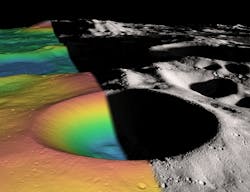Laser altimeter estimates ice content in crater at Moon's south pole
Washington, DC--Data from the Laser Altimeter aboard NASA's Lunar Reconnaissance Orbiter (LRO) spacecraft indicates that ice may comprise as much as 22% of the surface material in the Shackleton crater on the moon's south pole. They found the crater's floor is brighter than those of other nearby craters, which is consistent with the presence of small amounts of lunar ice. This information will help researchers understand crater formation and study other uncharted areas of the moon. The findings are published in the journal Nature.
The spacecraft mapped Shackleton crater with unprecedented detail, using a laser to illuminate the crater's interior and measure its albedo or natural reflectance. The laser light measures to a depth comparable to its wavelength, or about a micron. The team also used the instrument to map the relief of the crater's terrain based on the time it took for laser light to bounce back from the moon's surface using light detection and ranging (LIDAR). The longer it took, the lower the terrain's elevation.
In addition to the possible evidence of ice, the group's map of Shackleton revealed a remarkably preserved crater that has remained relatively unscathed since its formation more than three billion years ago. The crater's floor is itself pocked with several small craters, which may have formed as part of the collision that created Shackleton, named after the Antarctic explorer Ernest Shackleton. Like several craters at the moon's south pole, the small tilt of the lunar spin axis means Shackleton crater's interior is permanently dark and therefore extremely cold. The ultrahigh-resolution map provides strong evidence for ice on both the crater's floor and walls. "There may be multiple explanations for the observed brightness throughout the crater," said Maria Zuber, the team's lead investigator from the Massachusetts Institute of Technology. "For example, newer material may be exposed along its walls, while ice may be mixed in with its floor."
The initial primary objective of LRO was to conduct investigations that prepare for future lunar exploration. Launched in June 2009, LRO completed its primary exploration mission and is now in its primary science mission. LRO was built and is managed by Goddard. This research was supported by NASA's Human Exploration and Operations Mission Directorate and Science Mission Directorate at the agency's headquarters in Washington.
SOURCE: NASA; www.nasa.gov/mission_pages/LRO/news/crater-ice.html
IMAGE: Elevation (left) and shaded relief (right) image of Shackleton, a 21 km diameter permanently shadowed crater adjacent to the lunar south pole. The structure of the crater's interior was revealed by a digital elevation model constructed from over 5 million elevation measurements from the Lunar Orbiter Laser Altimeter. (Courtesy NASA/M.T. Zuber et al., Nature 2012)
